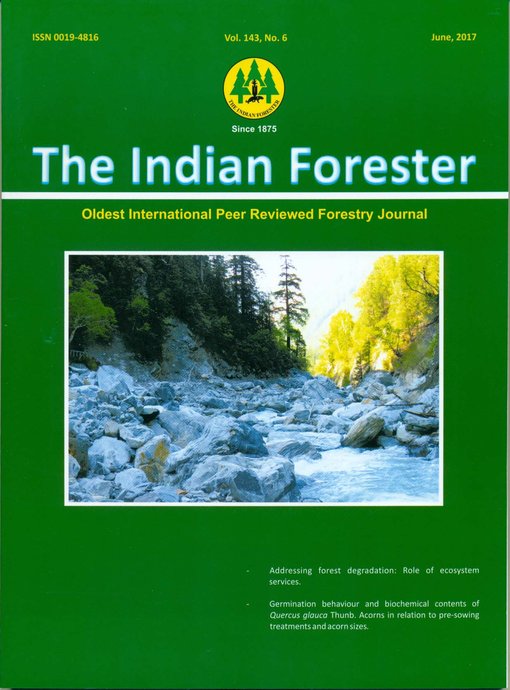Evaluation of Seed Fertility in Relation to Diameter Classes of Diploknema butyracea (Roxb.) H. J. Lam
DOI:
https://doi.org/10.36808/if/2017/v143i6/115830Keywords:
Diploknema butyracea, Germination, Vigour, Seed Yield, Seed Fertility.Abstract
Diploknema butyracea is a fast growing and lesser-known species. The trees of this species were grouped into different diameter classes for assessment of seed germination and seedling viour. It is investigated from the results that there was no definite relationship between size of tree and seed fertility in this species.References
Abdul-Baki A. A. and Anderson J.D. (1973). Vigour determination in soya bean seed by multiple criteria. Crop, 13: 630 -632.
Ahmed Z.U., Hassan M.A., Begum Z.N.T., Khondker M., Kabir S.M.H., Ahmed M. and Ahmad A.T.A. (2009). Encyclopedia of flora and Fauna of Bangladesh: Angiosperms: Dicotyledons: Ranunculaceae- zygophyllaceae. Vol. 10 Asiatic Society of Bangladesh, Dhaka, 1-580.
Arya S.R., Bhagat S., Singh V. and Singh O. (1994). Seed fertility in relation to tree size of Abies pindrow and Picea smithiana. Indian Forester, 120(8): 677 - 681.
Awasthi Y.C., Bhatnagar S.C. and Mitra C.R. (1975).Chemurgy of Sapotaceous Plants: Madhuca species of India. Economic Botany, 29: 380–389.
Awasthi Y.C. and Mitra C.R. (1961). Flavonoids of Madhuca butyracea Nut- Shell. J. Organic Chemistry, 27: 1636.
Awasthi Y.C. and Mitra C.R. (1968). Madhuca latifolia: triterpenoid constituents of the trunk bark. Phytochemistry, 7(8): 1433 -1434.
Balakrishnan N.P. (1981). Flora of Jowai, Vol I. Botanical Survey of India, Howrah.
Banerji R., Nainan M.O., Misra G. and Nigam S.K. (1988). Oil Seed and their Utilization In: Chemurgy of Madhuca butyracea Macbride. (Suri, R.K. and K.C. Mathur eds). pp 13 – 22, International book distributors, Dehradun, India.
Brandis D. (1906). Indian trees: An Account of trees, shrubs, Woody Climbers, bamboos and Palm Indigenous or commonly cultivated in the British Indian Empire. Fifth impression (1971). Bishen Singh Mahendra Pal Singh: Dehradun, India.
Champion H.G. and Seth S.K. (1968). General Silviculture for India. G.O.I. Publication Branch, deptt. Pf Printing & Stationary, New Delhi p. 131.
Czabator F.J. (1962). Germination value: an index for combining speed and completeness of pine seed germination. For. Sci., 8(4): 386 – 396.
Deb D.B.(1981). The Flora of Tripura state, vol. I. Today and Tomorrows, Printers and Publishers, New Delhi.
FAO (2010). Planted forests in sustainable forest management –A statement of principles, 15pp. Rome.
Haridasan K. and Rao R.R. (1985). Forest flora of Meghalaya. Vol. I. Bishen Singh Mahandra Pal Singh Publishers, Dehradun.
ISTA (1999). International Seed Testing Association. International rules for seed testing, Seed Science and Technology, 27: 369 – 380.
Joseph, J (1982). Flora of Nongpoh and vicinity, east Khasi Hills district Meghalaya. Forest Department, Government of Meghalaya.
Khanna L.S. (1977). Principles and Practices of Silviculture, Khanna Bandhu, Tilak Marg, Dehradun, p.192.
Khetwal K.S. and Verma D.L. (1986).Flavonoids from the flowers of Diploknema butyracea. Fitoterapia, 57(2): 128
Kureel R.S., Gupta A.K. and Pandey A. (2008). Cheura: a wonder tree borne oil seed. Pub. National Oil Seed and Vegetable Oil Development Board, Ministry of Agriculture, GOI, New Delhi, pp.8.
Mishra G., Banerji R. and Nigam S.K. (1991). Butyrpenoidal sapogenin from Madhuca butyracea. Phytochemistry, 30: 2087 – 2088.
Mitra C.R. and Awasthi Y.C. (1962). Constituents of Madhuca latifolia and M. butyracea nuts. J. Scientific and Industrial Research, 21(D): 102 – 103.
Mukerji B. (1951). Indian pharmaceutical Codex, C.S.I.R., New Delhi. I, 144.
Majumdar K., Datta B.K. and Uma Shankar (2012). Establishing continuity in distribution of Diploknema butyracea (Roxb.) H.J. lam in Indian subcontinent. J. Research in Biology, 2(7): 660 - 666.
Nawa Bahar (2011). Cheura (Diploknema butyracea (Roxb.) H.J. Lam): an important tree for poverty alleviation. Indian Forester, 137: 1344 – 1345.
Negi K.S., Tewari J.K., Gaur R.D. and Pant K.C. (1988). Indian butter tree - Asiandra butyracea(Roxb.) Baehri, some ethnobotanical notes. Indian J. Forestry, 11 (4): 319 -321.
Rajkumar M. and Parthasarathy N. ( 2008). Tree diversity and structure of Andaman giant evergreen forests, India. Taiwania, 53: 356 – 368.
Singh L. and. Khan M.H (2004). Status and potential of Chiuri( Aesandra butyracea) in Nepal. Plant – Archives, 4(1): 203 -204.
SinghV., Bana O.P.S. and Sah V.K. (1997). Effect of tree diameter classes on seed yield, germination and early seedling growth in Himalayan cedar (Cedrus deodara Royle ex D. Don). J. Hill Research, 10(2): 77-81.
Singh N.P., Chauhan A.S. and Mondal M.S. (2000). Flora of Manipur. Vol I Ranunculaceae –Asteraceae, Botanical Survey of India, Calcutta.
Sundriyal M. (1999). Distribution, propagation and nutritive value of some wild edible plants in the Sikkim Himalayas. Ph.D. Thesis Garhwal University Srinagar, India.
Troup R.S. (1921). The Silviculture of Indian Trees, Vol. I –III, Clarendron Press Oxford.
Downloads
Downloads
Published
How to Cite
Issue
Section
License
Unless otherwise stated, copyright or similar rights in all materials presented on the site, including graphical images, are owned by Indian Forester.





